�
SOA
WATCH Border Delegation Report Back
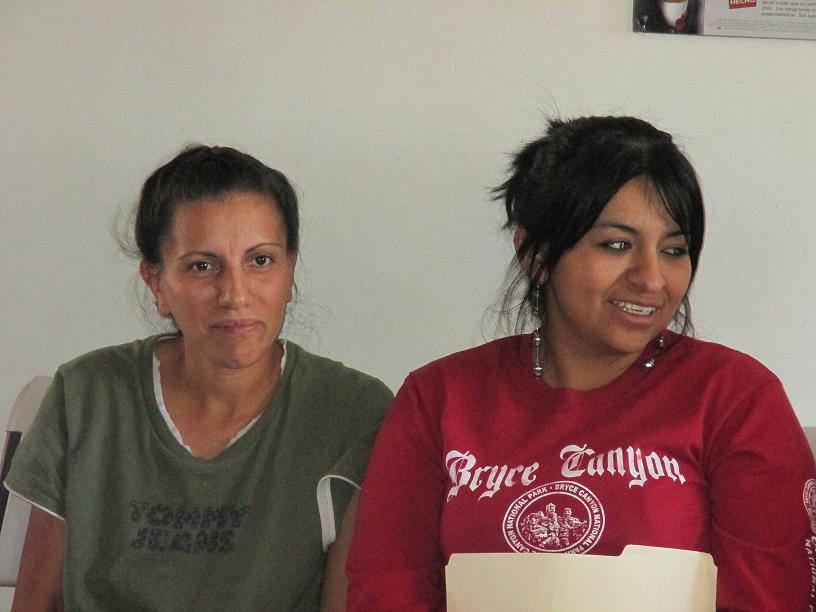 Maria's
roommates from the shelter in Nogales, Mexico, carried
her gently into the room where members of our SOAW
Border delegation had gathered to share with some of the
migrants recently deported to Mexico. After five days
traversing Arizona's Sonora desert, her frail and
swollen legs had given out, and she was unable to walk.
Next to her sat Sofia, able to walk -barely -but with
large black and purple bruises on her arms from six days
of iv fluids. She had been helicoptered out of the
desert in an unconscious state. Both wore shy smiles
that seemed to contrast the reality they had just lived.
Or maybe not. Maybe they revealed an awareness of the
sheer miracle of just being alive.�
Maria's
roommates from the shelter in Nogales, Mexico, carried
her gently into the room where members of our SOAW
Border delegation had gathered to share with some of the
migrants recently deported to Mexico. After five days
traversing Arizona's Sonora desert, her frail and
swollen legs had given out, and she was unable to walk.
Next to her sat Sofia, able to walk -barely -but with
large black and purple bruises on her arms from six days
of iv fluids. She had been helicoptered out of the
desert in an unconscious state. Both wore shy smiles
that seemed to contrast the reality they had just lived.
Or maybe not. Maybe they revealed an awareness of the
sheer miracle of just being alive.�
The desert had taken the power out of Maria's legs, but
it did not claim her spirit. Nor did the 651-mile steel
Border wall, �nor the 18 billion dollars spent yearly by
the US government �to militarize the border. �Maria
informed us that once the swelling goes down and her
knees are able to again carry her 100-lb body, she would
be trying to cross the desert once more. ���
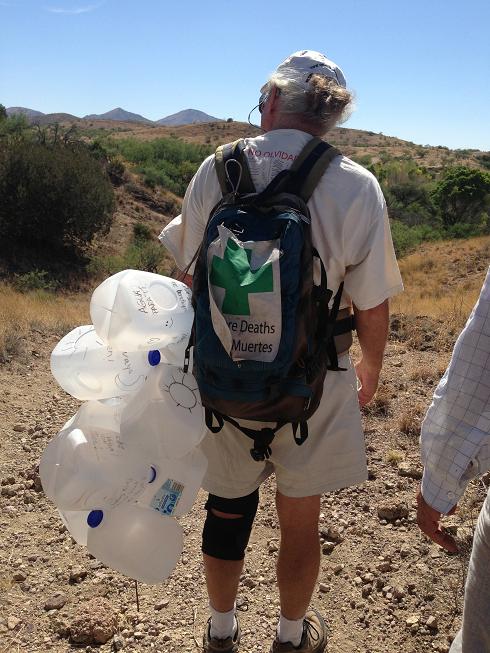 I
was astonished, having just walked a small piece of that
same desert two days earlier. We had gone to do a water
drop on a migrant trail with the expert guidance of No
More Death's volunteer, Steve. �This group, along with
the Samaritans, makes daily treks it the desert to leave
water for migrants. The fact that we picked up more
empty jars than we left was testimony that it was doing
its purpose: saving lives.
I
was astonished, having just walked a small piece of that
same desert two days earlier. We had gone to do a water
drop on a migrant trail with the expert guidance of No
More Death's volunteer, Steve. �This group, along with
the Samaritans, makes daily treks it the desert to leave
water for migrants. The fact that we picked up more
empty jars than we left was testimony that it was doing
its purpose: saving lives.
Although I drank water like a camel and knew that an air
conditioned van was awaiting me, � I was �utterly
depleted after only after three hours in the desert, one
of the most brutal in the world. �The desert is
scattered with shrines and marked by where dead bodies
had been retrieved: 5,000 of them in the past 15 years,
perhaps more that the desert will never reveal. Still
reeling from my own mini journey, I asked Maria why take
this risk �again? Her answer was one I immediately
understood: her children were on the other side.
State-of-the-art military technology doesn't stop �moms
like Maria,�even
as the industrial military complex falls over each other
inthe void of wars, to gain bids for the extra $6.8
billon��the
Senate wants to spend for more border militarization.
They are willing to risk everything to be united with
their children, to put food on their tables. What this
militarization does is to push migrants to the deadliest
route. Even as overall immigration is waning in recent
years, border deaths remain constant.�
A hundred years ago, if Maria's name were Laura Ingalls,
her story of braving treacherous lands to forge a new
life or reunite with family would have been part of the
mythical fabric of our nation. Children in elementary
schools would be required to read her tale. One �difference:
Laura was stepping into lands never owned by her
ancestors , while Maria was heading to land that had
long been part of her native Mexico.��
But instead of being a heroine, �Maria is a criminal.
Today, while Washington debates the decriminalization of
some immigrants (after all, our society would fall apart
without them), quietly, our tax dollars are going �to
criminalize and �imprison tens of thousands of
immigrants in our own communities. ����
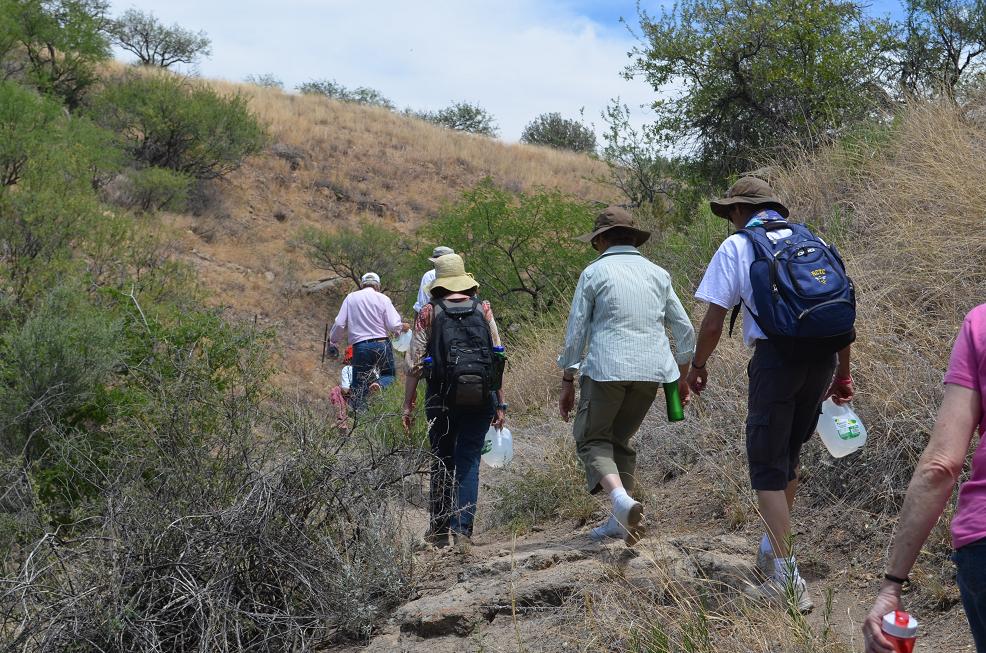 We
witnessed this public policy schizophrenia in the
Federal� courthouse in Tucson where 60 immigrants -
shackled with chains on their hands and feet, looking
exhausted after days in the desert - were paraded in
groups of five before a judge, and sentenced to an
average of four month in jail. Their crime was entry
without inspection. �The
whole process, called Operation Streamline, took only
two hours andcost tax payers a million dollars.
And that price tag is just for one session in one
courthouse on one day. The same thing happens in six
border city courthouses each week day. And the new
Senate bill hopes to triple that.��
We
witnessed this public policy schizophrenia in the
Federal� courthouse in Tucson where 60 immigrants -
shackled with chains on their hands and feet, looking
exhausted after days in the desert - were paraded in
groups of five before a judge, and sentenced to an
average of four month in jail. Their crime was entry
without inspection. �The
whole process, called Operation Streamline, took only
two hours andcost tax payers a million dollars.
And that price tag is just for one session in one
courthouse on one day. The same thing happens in six
border city courthouses each week day. And the new
Senate bill hopes to triple that.��
Immediately after Streamline, the immigrants are
escorted to prison, mostly private ones. Schools in the
US may be closing, but private prisons, such as those
run by the�Corrections Corporation of America (CCA),�are
being opened and expanded at an astonishing rate. This
is mostly due to the new trend of massively
incarcerating immigrants for the crime of having entered
our country through the back door. Fully 60% of Tucson's
federal court time is spent with deportation cases,
leaving them unable to adequately deal with truly
serious crime.�
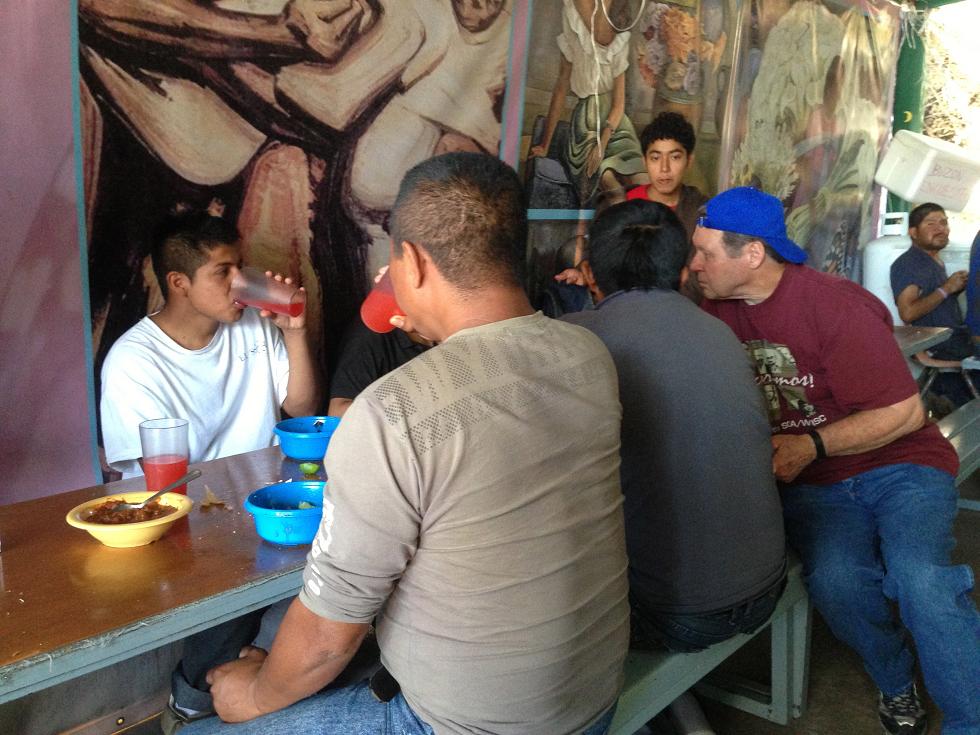 President
Obama is currently on track to deport more immigrants
during his 6 years - more than 2 million - �than the sum
of all immigrants deported by in the 100 years from
1892-1997. Most worrisome is that over 200,000 families
have already been separated by such deportations in the
past two years alone. �For those processed through
Operation Streamline, first comes prison, then detention
center, then deportation.��
President
Obama is currently on track to deport more immigrants
during his 6 years - more than 2 million - �than the sum
of all immigrants deported by in the 100 years from
1892-1997. Most worrisome is that over 200,000 families
have already been separated by such deportations in the
past two years alone. �For those processed through
Operation Streamline, first comes prison, then detention
center, then deportation.��
�
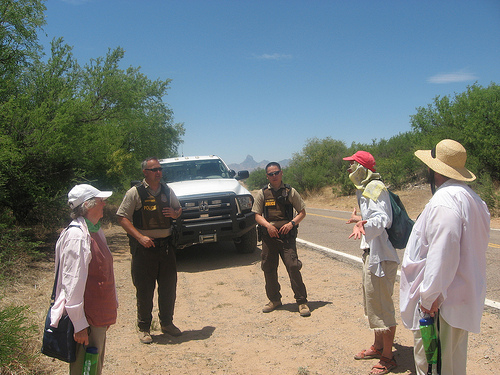
Maria was lucky to "just" go straight to ICE detention.
After traversing 5 miserable days through the blistering
heat of the day and the brutal cold of the night, her
coyote's pick up never arrived and she ended up in a
vehicle of the Border Patrol. They promptly shackled her
feet and hands and delivered her prostrate to the
detention center. Because she was so thin, her wrists
kept slipping out of the handcuffs, and she so, she
explained, she would continually shove them back into
the handcuffs herself to avoid being �reprimand by the
Border Patrol.���
�
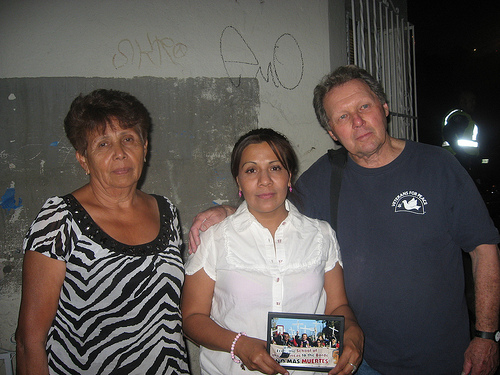 Tragically,
the Border Patrol sometimes goes beyond reprimanding.�Such
was the case of Jose Antonio Elena Rodriguez who was
actually on the Mexican side of the border wall, when he
was brutally murdered by a US Border Patrol agent last
October, riddled by 13 bullets to the head and back.�That
was the punishment for a volley of rocks that he
supposedly lobbed over the fence. As we gathered with
Fr. Roy Bourgeois to give Jose's family a photo of the
cross that Roy had carried at last year's vigil, bearing
Jose's name, we realized how impossible it would have
been for rocks to even reach over the top of a 30 foot
wall perched on top of a 30 foot hill.����
Tragically,
the Border Patrol sometimes goes beyond reprimanding.�Such
was the case of Jose Antonio Elena Rodriguez who was
actually on the Mexican side of the border wall, when he
was brutally murdered by a US Border Patrol agent last
October, riddled by 13 bullets to the head and back.�That
was the punishment for a volley of rocks that he
supposedly lobbed over the fence. As we gathered with
Fr. Roy Bourgeois to give Jose's family a photo of the
cross that Roy had carried at last year's vigil, bearing
Jose's name, we realized how impossible it would have
been for rocks to even reach over the top of a 30 foot
wall perched on top of a 30 foot hill.����
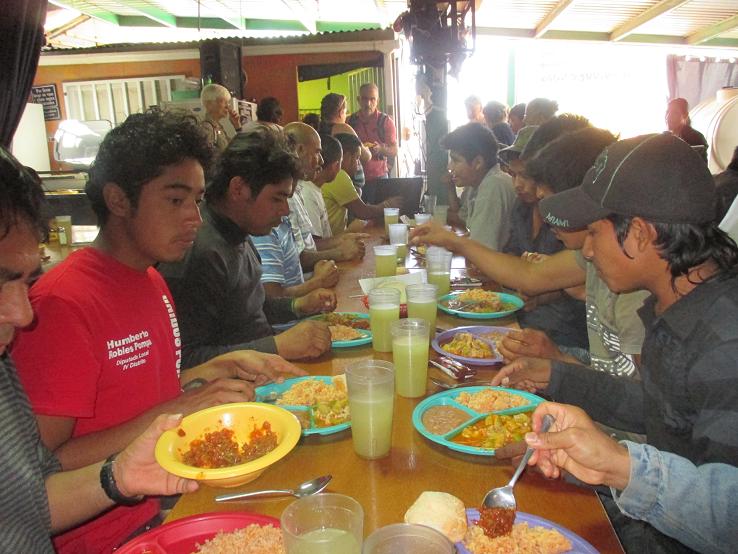 In fairness, several of the migrants reported that the
Border Patrol had rescued them from sure death. �That
was Tanya's case, when the Border Patrol searched all
night for her, after her husband was able to contact
them after she passed out in the desert. Once found, she
was airlifted to a hospital in Phoenix. What is clear is
that the blame for the rise in deaths in the desert does
not lie on the shoulders of the Border Patrol, but on
the policy that has shaped it.��
In fairness, several of the migrants reported that the
Border Patrol had rescued them from sure death. �That
was Tanya's case, when the Border Patrol searched all
night for her, after her husband was able to contact
them after she passed out in the desert. Once found, she
was airlifted to a hospital in Phoenix. What is clear is
that the blame for the rise in deaths in the desert does
not lie on the shoulders of the Border Patrol, but on
the policy that has shaped it.��
So,
why do they come at all? We asked the staff of the Kino
Border Initiative, whose services include serving
hundreds of meals a day to deported migrants on the
Mexican side, and running a shelter for recently
deported women. Kino Education Director West Cosgrove
replied that during his 17 years at border cities he has
heard multiple versions that boil down to this brief
explanation: �We
are here because you were there.�This
was affirmed when Sister Engracia told us that the
biggest increase in recent migrants are those from
Honduras. They come fleeing the violence unleashed by
the �2009 coup carried out by SOA graduates and
continued under a regime supported by US military aid.��
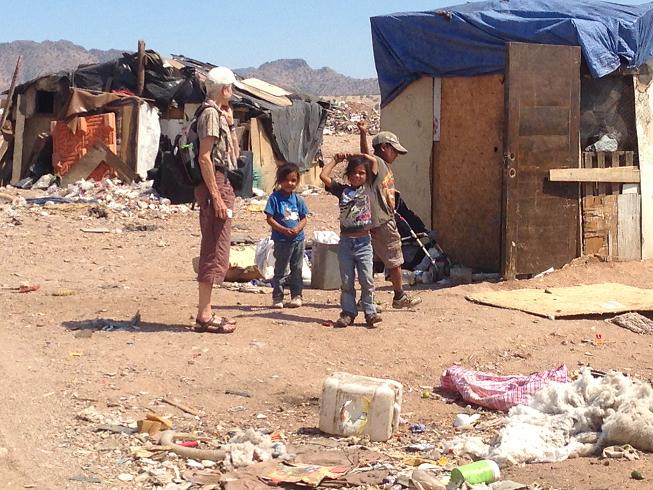
The biggest way that "we were there" in Mexico is of
course via NAFTA, the free trade agreement that promised
to bolster Mexico's economy, but destroyed the
livelihood of millions of small farmers who couldn't
possibly complete with subsidized giant US agro business.
It is no wonder that the wall started to be built in
1994,the year that NAFTA was approved. Maquiladoras from
the U.S. moved in, paying wages so low that a community
at the Nogales, MX trash dump that we visited included
former maquila workers who made more in the dump than
the factory.
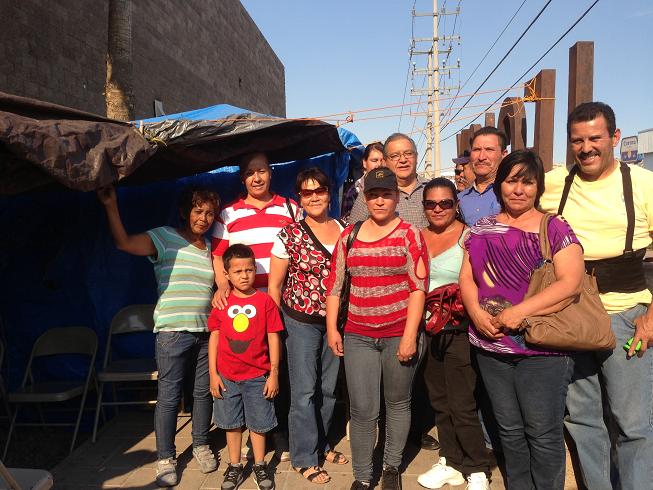
�
A group of workers from the closed Legacy printer ink
factory met with us under a tent they had installed
outside the abandoned factory, demanding the assets in
lieu of the unpaid wages owed by the owner, who closed
the factory and hightailed it back to the U.S. and his
numerous other businesses.
�
The
School of the Americas has also contributed to the
dangersfaced by migrants, through their training of
elite Mexican soldiers, many ofwhom deserted the army to
became Zetas, the hired assassins of a Mexican
drugcartel.�Migrants
passing through the desert must pay cartels to enter and
leave the border towns,� then to their cartel coyotes to
lead them through the desert. Minimum price for these
services: $4,000, per migrant, not including frequent
rapes, torture and sometimes death at the hands of the
coyotes. Migrants get a $500 discount if they agree to
carry a 50-pound sack of marijuana. �
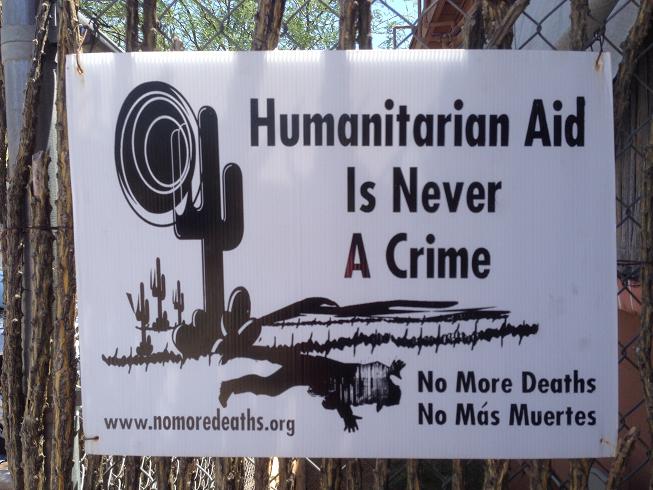 The
environment is also suffering irreversible damage
because of border militarization policies, affecting pristine
wild lands, national forests, and refugees for wildlife
such as�pygmy
owls and desert bighorn sheep, contributing also to
severe flooding.��In
a bizarre twist, Sierra Club activist Dan Millis was
charged with littering when distributing water jugs on
migrant trails, even though he and other No More Deaths
volunteers were simultaneously picking up boxes of trash
in the desert. Dan refused to pay the ticket, and was
later convicted in federal court. Several months earlier,
Dan
had discovered the remains of 14-year old Josseline
Hernandez who was left to die in the desert while
journeying to reunite with her mother in California.
The
environment is also suffering irreversible damage
because of border militarization policies, affecting pristine
wild lands, national forests, and refugees for wildlife
such as�pygmy
owls and desert bighorn sheep, contributing also to
severe flooding.��In
a bizarre twist, Sierra Club activist Dan Millis was
charged with littering when distributing water jugs on
migrant trails, even though he and other No More Deaths
volunteers were simultaneously picking up boxes of trash
in the desert. Dan refused to pay the ticket, and was
later convicted in federal court. Several months earlier,
Dan
had discovered the remains of 14-year old Josseline
Hernandez who was left to die in the desert while
journeying to reunite with her mother in California.
As the Senate brings to its chambers the debate on the
Comprehensive Immigration Reform, it is clear to those
at the border that this bill is neither comprehensive,
as it does not address the root causes of migration. Nor
does it give priority to the human rights of migrants
and families. Before anyone can even qualify for the
complex steps to a legal status,��border security
triggers" will require an additional $6.8 for more
border militarization, assuring more deaths in the
desert.
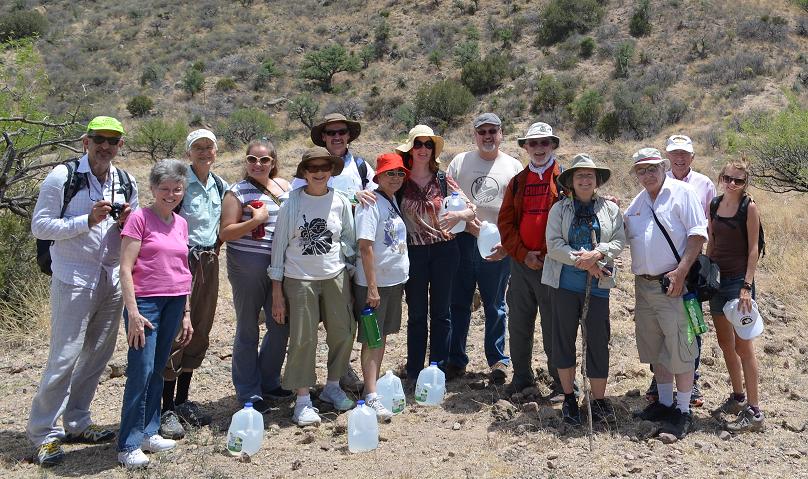
At the border I heard some of the most horrific tales of
my recent journeys through throughout the Americas,
right in my own country. But, I also witnessed some of
the most concrete expressions of solidarity, such as
dropping water on a migrant trail in the desert. Not all
of us live in the desert. But we all lived in
communities that depend on immigrants. Isabel Garcia of
Coalicion de Derechos Humanos told us, the border is
everywhere.� I invite you to drop water in the desert of
our treatment of immigrants, whether that is by emailing
your Senator to demand a stop to border militarization,
joining me at the Stewart�
Detention Center at the SOAWatch vigil, or
speaking out for immigrant rights in your own community.
�
�